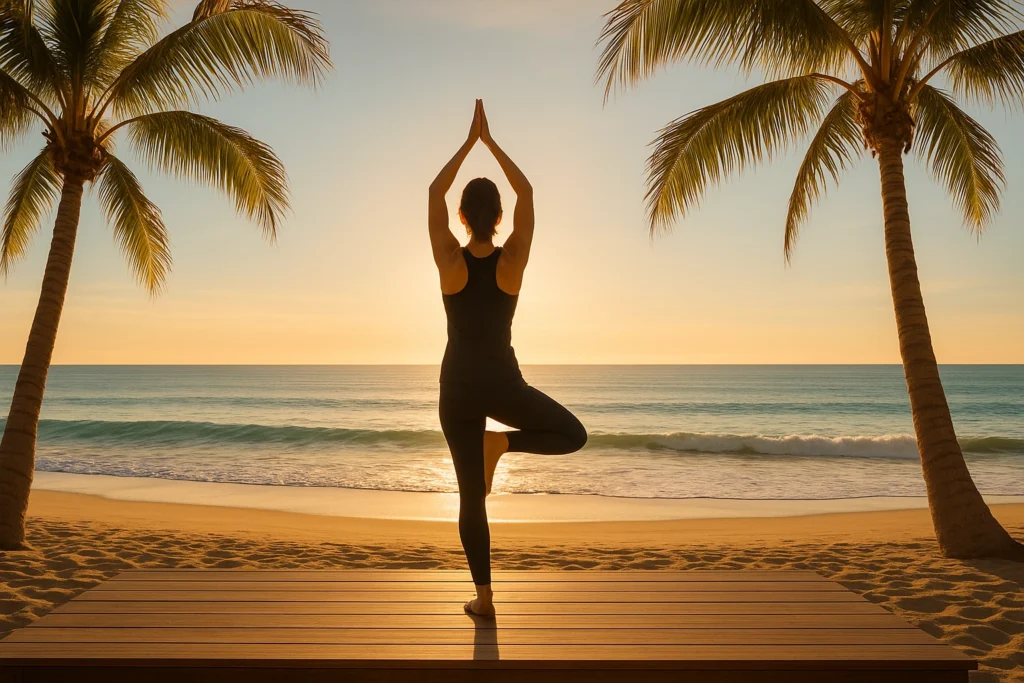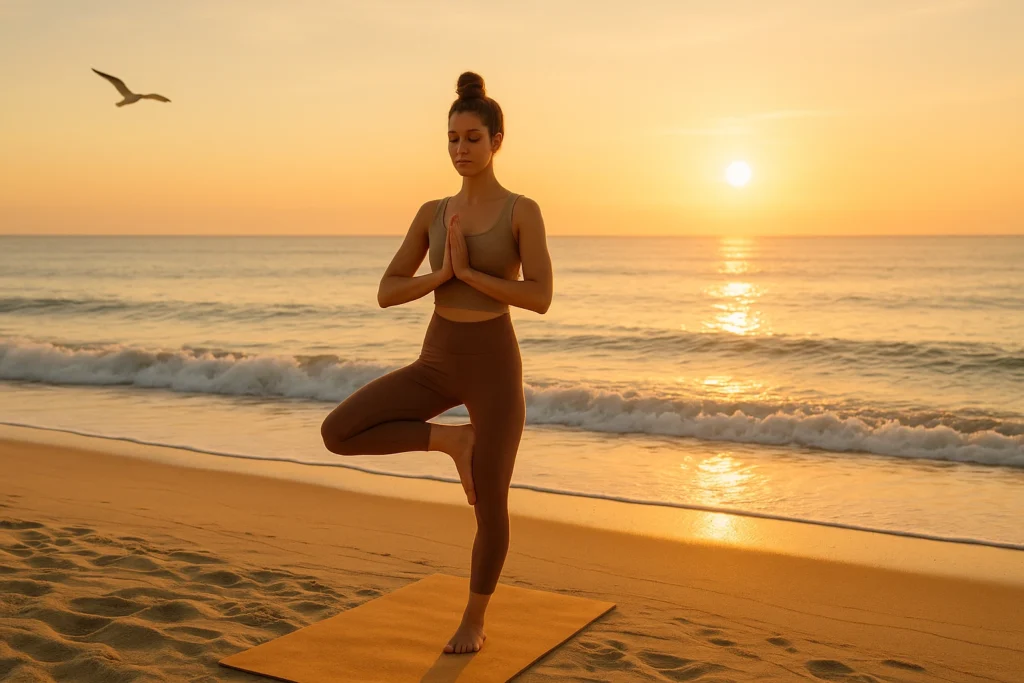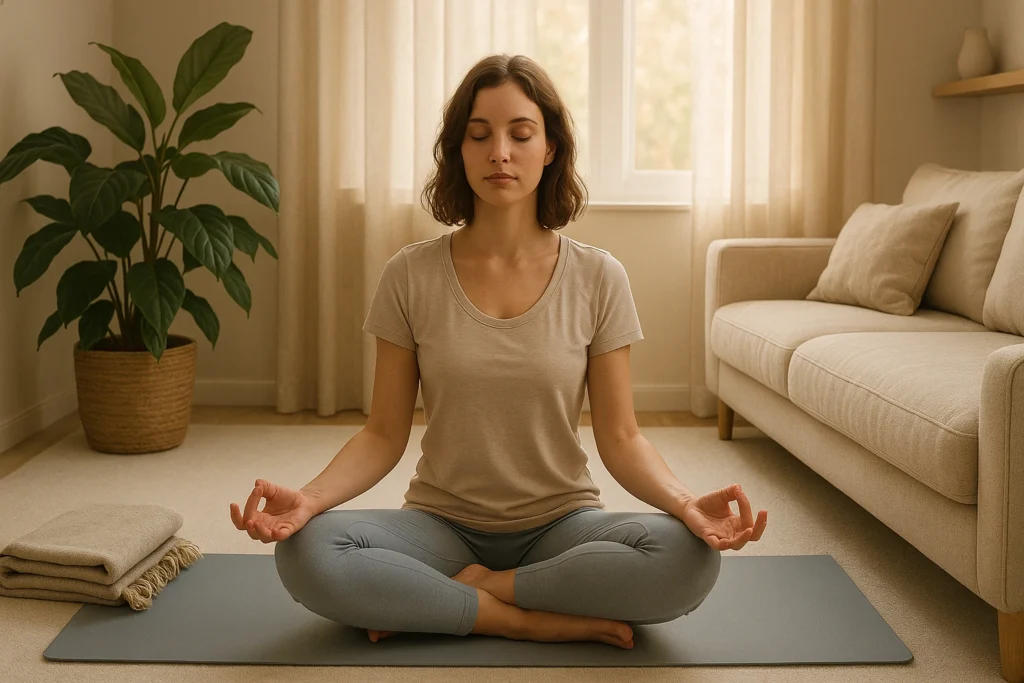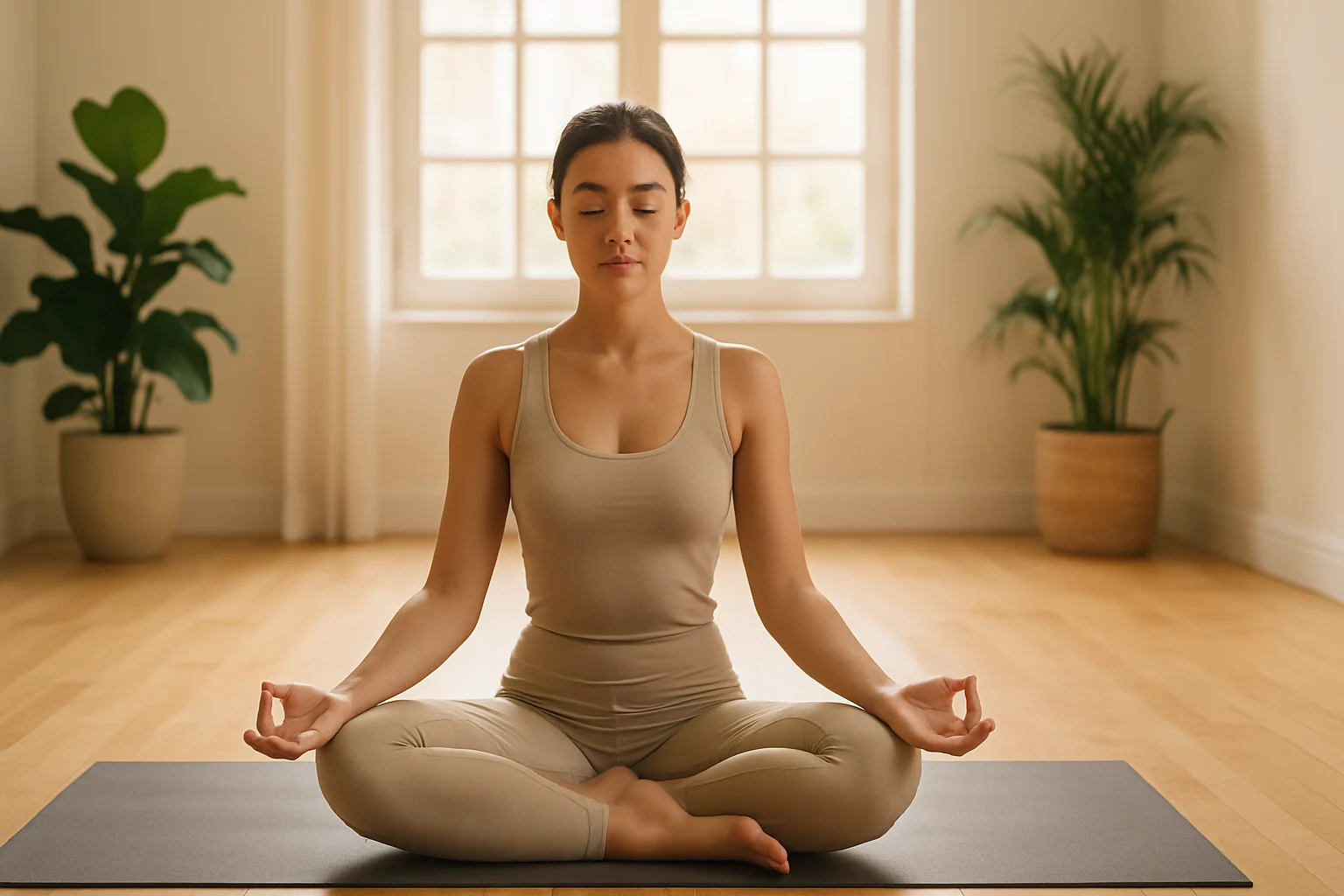
Struggling with yoga hamstring stretches to relieve tight, uncomfortable muscles? Tight hamstrings can contribute to lower-back discomfort for some people, alongside other factors. These 4 beginner-friendly hamstring yoga poses may help you build flexibility safely. With about 10 minutes a day and simple props, you may gradually ease tension and move more comfortably. Exploring yoga for leg flexibility can support your range of motion. For a broader foundation—including essentials like mats and straps—see our yoga flexibility guide.
Table of Contents
- Key Takeaways for Flexible Legs
- Understanding Your Hamstrings
- Why These Yoga Stretches Work
- Tips for Safe Hamstring Stretching
- My Journey with Hamstring Flexibility
- Essential Yoga Hamstring Stretches for Beginners
- Hamstring Stretch Summary
- Hamstring Stretch Starter Checklist
- Tailored Yoga Stretches for Hamstrings
- Integrating Yoga Stretches into Your Routine
- Lifestyle Tips for Hamstring Flexibility
- Hamstring Stretch Player
- FAQs on Hamstring Stretching
- Embrace Your Hamstring Stretch Journey
Key Takeaways for Hamstring Flexibility
- Gentle Approach: Never force a stretch; listen to your body to avoid pain.
- Consistency Matters: Practice a few minutes daily for better results than sporadic long sessions.
- Use Props: Yoga blocks, straps, or blankets make poses accessible for tight hamstrings and support flexible hamstrings.
- Improve Posture: Regular yoga stretches for hamstrings can enhance posture and reduce back pain.
- Breathe Deeply: Deep breathing relaxes muscles for safer, deeper stretching.
Understanding Your Hamstrings
Before exploring yoga stretches, let’s understand the hamstrings. These three muscles run along the back of your thigh, from your glutes to below your knee. They bend your knee and extend your hip, playing a key role in movement.
Why Do Hamstrings Get Tight?
Several factors cause tightness, for example:
- Prolonged Sitting: Desk jobs or long commutes shorten hamstrings. 🛋️
- Lack of Stretching: Skipping full-range leg movements tightens muscles.
- Activities: Running or cycling can strain hamstrings without stretching.
- Poor Posture: A tilted pelvis adds stress to hamstrings.
Tight hamstrings can cause lower back pain, knee issues, or restricted movement, so regular, gentle stretching can help.
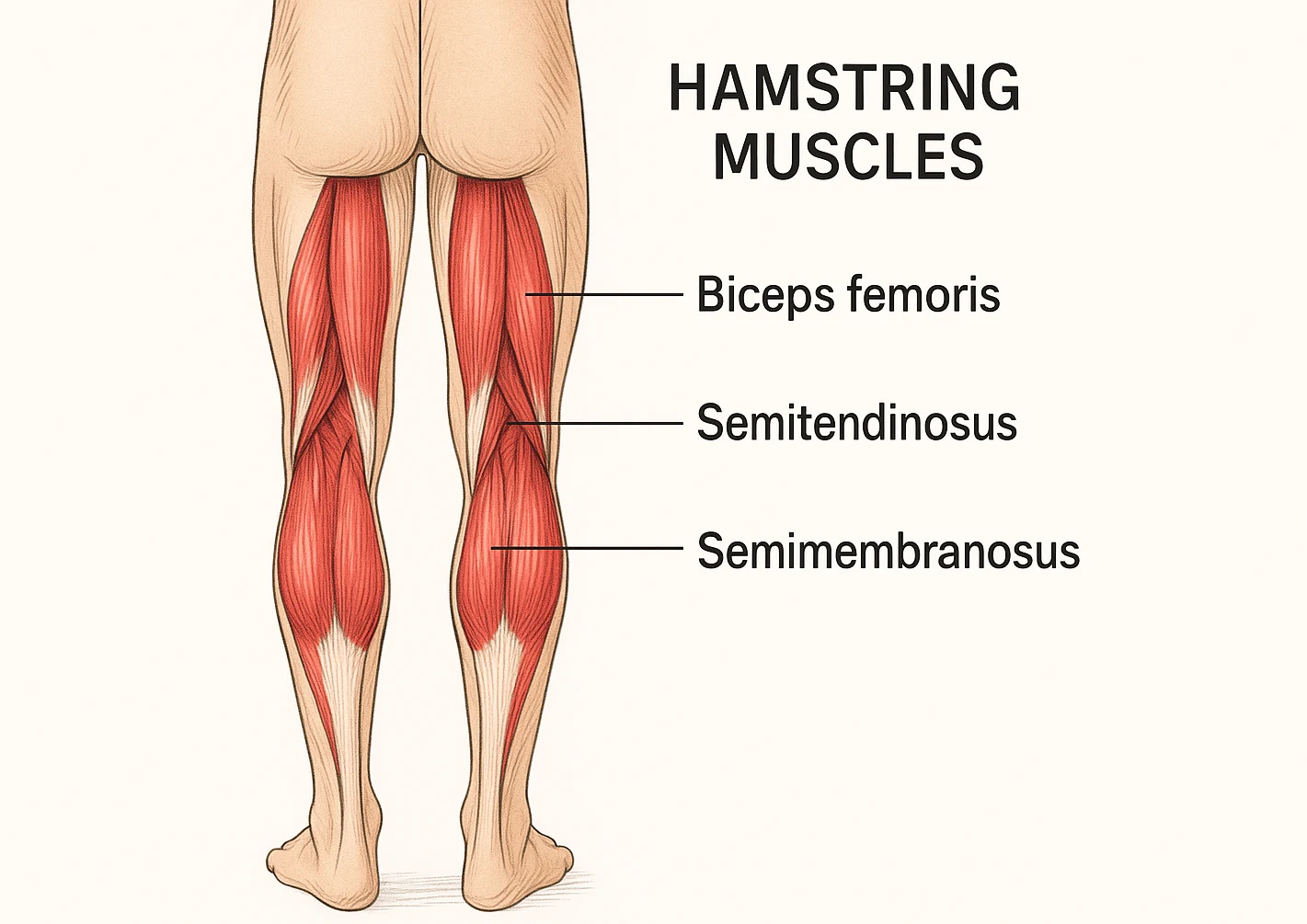
Why Yoga Hamstring Stretches Work
Yoga offers a patient, body-aware way to improve hamstring flexibility. Instead of forcing range, you pair steady breathing with small, repeatable movements that let muscles relax safely. Over time you also build balance and strength—not just length. Resources like Yoga Journal share ideas for making practice sustainable, which is why many beginners find these hamstring-focused yoga stretches approachable.
Tips for Safe Hamstring Stretching
To ensure your yoga poses for tight hamstrings are safe and effective, follow these tips:
- Warm Up: Walk or do sun salutations for 3-5 minutes to prepare muscles.
- Listen to Your Body: Feel a stretch, not pain. Ease out if it hurts. 👂
- Breathe Deeply: Inhale to lengthen, exhale to deepen stretches safely.
- Stay Consistent: Short, regular sessions beat intense, infrequent ones.
- Use Props: Blocks or a yoga strap for better flexibility bring poses within reach comfortably.
- Be Patient: Flexibility builds over time, so celebrate small wins.
- Mix It Up: Try simple hamstring stretch routines that you can do at home in just a few minutes.
Your body is your temple. Treat it with kindness and listen to its whispers, not its screams.
This post has affiliate links. We may earn a commission. Learn more.
My Journey with Hamstring Flexibility
When I started yoga, my hamstrings were so tight that bending to tie my shoes felt like a workout! After weeks of gentle yoga for flexibility, I noticed I could move more freely. For example, reaching for my toes no longer felt impossible. This personal transformation inspired me to share these beginner-friendly stretches with you—and show you how to unlock flexible hamstrings at your own pace.
Essential Yoga Hamstring Stretches for Beginners
Below are four safe yoga poses to stretch tight hamstrings, nicknamed for fun, with step-by-step guides. Hold each pose for about a minute while taking slow, steady breaths.
1. Seated Forward Fold (Paschimottanasana): The Hamstring Hugger
Why It Works: This timeless yoga hamstring stretch lengthens your hamstrings and spine while calming the mind.
- Sit tall with legs extended, toes flexed toward the ceiling.
- Place a folded blanket under your sitting bones if your back rounds.
- Inhale, lengthening your spine like a string pulls your head up.
- Exhale, hinge forward from your hips, belly toward thighs.
- Rest hands on shins, ankles, or a strap around your feet.
- Bend knees slightly if hamstrings feel tight.
- Relax neck and shoulders, breathing deeply.
- Inhale, slowly roll up to exit.
Modifications for Tight Hamstrings
- Bend knees generously to keep your spine straight.
- Sit on a blanket to ease hip hinging.
- Use a strap to extend reach comfortably.
Alignment Tips
- Keep spine long, avoiding rounding.
- Fold from hips, not waist.
- Flex feet to protect knees.
2. Downward-Facing Dog (Adho Mukha Svanasana): The Hamstring-Waking Puppy
Why It Works: This full-body stretch also strengthens arms and relieves stress.
- Start in tabletop, wrists under shoulders, knees under hips.
- Spread fingers, press through palms.
- Tuck toes, exhale, lift hips to form an inverted V.
- Bend knees deeply to lengthen spine.
- Press chest toward thighs, head relaxed.
- Work toward straightening legs over time.
- Lower knees to exit.
Modifications for Tight Hamstrings
- Bend knees deeply to prioritize spine length.
- Walk hands forward for more space.
- Pedal feet to warm hamstrings.
Alignment Tips
- Press evenly through fingers.
- Keep spine long, not rounded.
- Rotate upper arms outward to broaden shoulders.
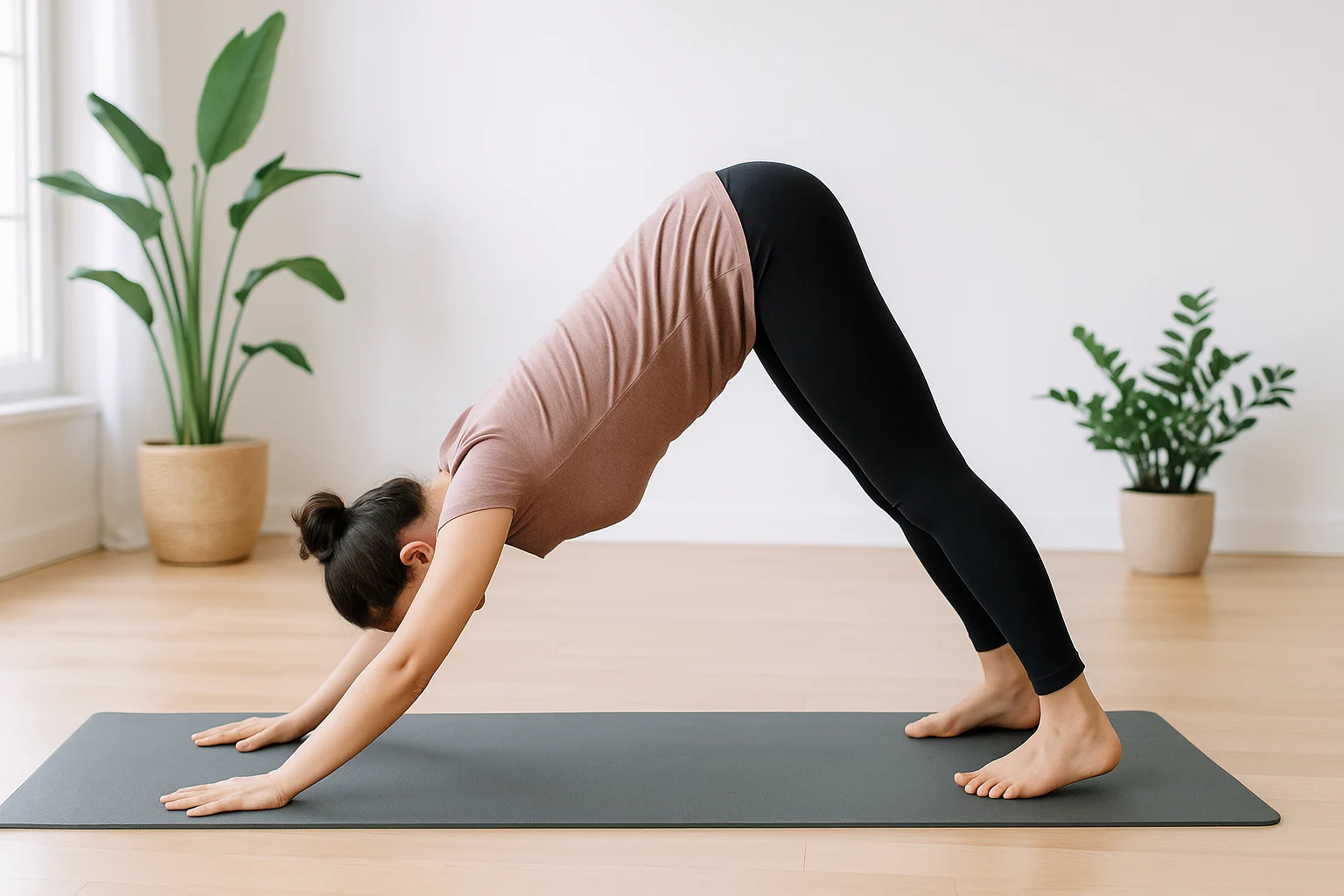
3. Pyramid Pose (Parsvottanasana): The Hamstring Balancer
Why It Works: This standing stretch boosts balance and deepens flexibility.
- Start in Mountain Pose.
- Step right foot back 2-3 feet, left foot forward.
- Angle right foot 45-60 degrees, left foot straight.
- Square hips to the front, like headlights.
- Inhale, lengthen spine.
- Exhale, hinge forward from left hip, belly to thigh.
- Place hands on shin, blocks, or floor.
- Keep spine long, bend front knee if needed.
- Engage core, inhale to lift up, repeat on other side.
Modifications for Tight Hamstrings
- Bend front knee slightly.
- Use blocks beside front foot.
- Shorten stance for less intensity.
Alignment Tips
- Keep legs active, not locked.
- Square hips to front.
- Maintain long spine.
4. Reclining Hand-to-Big-Toe Pose (Supta Padangusthasana): The Hamstring Soother
Why It Works: This gentle stretch may relax the lower back and is accessible to many beginners.
- Lie on back, knees bent, feet flat.
- Extend right leg along floor, or keep bent.
- Bring left knee to chest.
- Loop a strap around left foot’s ball, or hold calf.
- Extend left leg toward ceiling, knee soft if tight.
- Pull strap gently, keeping hips grounded.
- Relax shoulders, breathe deeply.
- Release strap, lower leg, repeat on other side.
Modifications for Tight Hamstrings
- Bend lifted knee generously.
- Keep bottom leg bent, foot flat.
- Use a scarf if no strap is available.
Alignment Tips
- Keep hips and lower back grounded.
- Flex lifted foot, toes toward face.
- Relax upper body.
Flexibility isn’t about touching your toes; it’s about moving freely and comfortably.
Hamstring Stretch Summary
| Pose Name | Difficulty | Benefits | Key Modification |
|---|---|---|---|
| Seated Forward Fold | Beginner | Stretches hamstrings, spine; calms mind | Bend knees generously |
| Downward-Facing Dog | Beginner-Intermediate | Stretches hamstrings, calves; strengthens arms | Bend knees deeply |
| Pyramid Pose | Beginner-Intermediate | Stretches hamstrings, hips; improves balance | Use blocks for hands |
| Reclining Hand-to-Big-Toe | Beginner | Stretches hamstrings, calves; may relax the back | Bend lifted knee |
Hamstring Stretch Starter Checklist
Here’s a quick starter list:
- ☑ Warm up for 3–5 minutes (a short walk or easy flows)
- ☑ Grab a strap, block, or blanket—whatever helps you reach comfortably
- ☑ Breathe steadily through each stretch
- ☑ Practice 3–5 times a week; short, regular sessions beat long, rare ones
Tailored Yoga Stretches for Hamstrings
Hamstring Stretch Routines for Runners
Runners often feel hamstring tightness from repetitive strides. Start with a dynamic warm-up before you hold stretches—think leg swings, then Downward-Facing Dog with gentle “pedaling.” After your run, Reclining Hand-to-Big-Toe Pose is a calm way to release tension.
Stretches for Desk Workers
If you sit a lot, hamstrings tend to tighten. Try a chair-friendly Seated Forward Fold during breaks, and a short standing Pyramid Pose beside your desk to reset your hips. A 5–8 minute hamstring stretch routine at your desk can help you feel looser and sit taller.
Integrating Yoga Stretches into Your Routine
Consistency is key for flexibility. Here’s how to make yoga stretches for hamstrings part of your life and cultivate hamstring flexibility:
- How Often? Practice 3-5 times weekly, even for 10-15 minutes.
- When?
- Morning: Wake up muscles. ☀️
- Post-Workout: Stretch warm muscles. 🏋️♀️
- Evening: Relax before bed. 🌙
- How Long? Hold stretches for 30-60 seconds, or longer if comfortable.
| Activity | Best Time for Stretches |
|---|---|
| Waking Up | Morning ☀️ |
| Post-Workout | After exercise 🏋️♀️ |
| Desk Job Relief | Mid-day breaks 💻 |
| Winding Down | Evening 🌙 |
Lifestyle Tips for Flexible Hamstrings
Beyond yoga, support your hamstrings with these habits:
- Stay Hydrated: Water keeps muscles supple. 💧
- Maintain Posture: A neutral pelvis reduces strain.
- Move Regularly: Walk every hour to avoid stiffness.
- Strengthen Glutes: Strong glutes ease hamstring load.
- Listen to Your Body: Rest if needed, consult a professional.
Hamstring Stretch Player
Seated Forward Fold — Steps
- Sit tall; legs extended; toes flexed up.
- Optional: sit on a folded blanket.
- Inhale, lengthen spine; exhale, hinge from hips.
- Hands to shins/ankles or loop a strap around feet.
- Keep knees softly bent if hamstrings are tight.
- Relax neck and shoulders; breathe steadily (30–60s).
Tip: Bend knees generously to keep the spine long.
Downward-Facing Dog (Pedal) — Steps
- From tabletop, tuck toes and lift hips to an inverted “V”.
- Bend knees to lengthen the spine first.
- Press chest toward thighs; head relaxed.
- Pedal feet slowly to warm hamstrings and calves.
- Work toward straighter legs over time; keep breathing (30–60s).
Tip: Prioritize spine length; deep knee bend is okay.
Reclining Hand-to-Big-Toe — Steps
- Lie on your back; bend knees; feet flat.
- Loop a strap around the ball of one foot.
- Extend that leg up; keep knee softly bent if needed.
- Gently draw the strap toward you; keep hips grounded.
- Relax shoulders; breathe (30–60s). Switch sides.
Tip: Keep the bottom leg bent and foot flat for comfort.
Frequently Asked Questions on Hamstring Stretching
Embrace Your Hamstring Stretch Journey
Beginning yoga stretches for hamstrings is a simple way to feel more mobile and at ease. Take your time, breathe, and skip anything that hurts—you don’t need to touch your toes today. Roll out your mat, try these beginner poses for tight hamstrings, and let flexibility build week by week. With steady practice, you may notice looser hamstrings and the broader benefits of yoga for leg flexibility in daily life.
